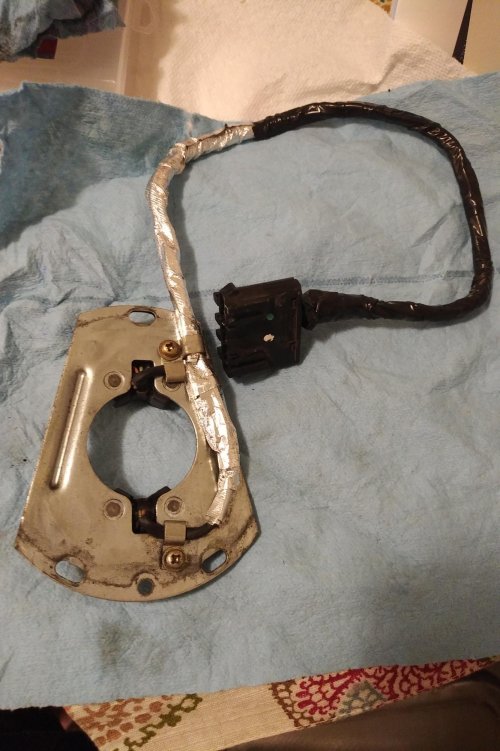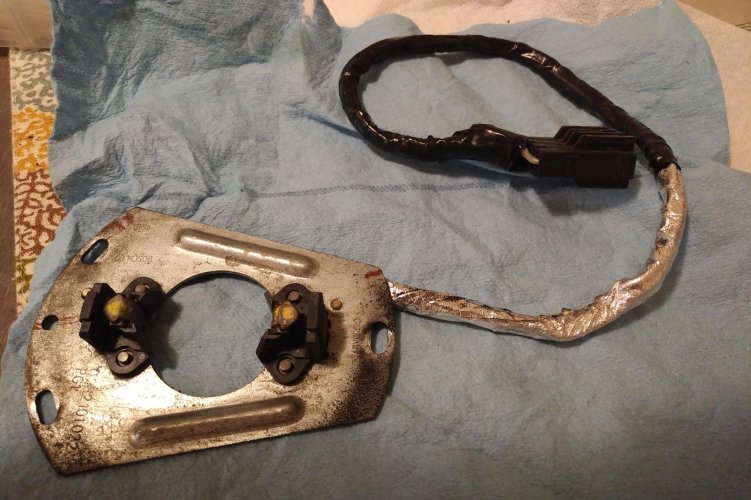senseamidmadness
Neglected Bike Adopter
I have a few questions for anybody that has experimented with the color-coded fusebox cat plugs, and about chasing down engine vibrations after doing all the typical things one does to reduce them.
My 1997 R850R, US model, with catalytic converter, currently has its stock "yellow" cat code plug. It has no intake or exhaust modifications but has a 3.5 bar fuel pressure regulator and a pair of Tills injectors. The charcoal canister had already been removed when I purchased this bike, but the owner that did so didn't remove all the plumbing that went with it. I removed the remaining vacuum hoses and the evap purge valve just recently and capped off the vacuum nipples on both throttle bodies.
My fueling feels a bit lean, especially when it starts up; the bike will die almost every time after first starting and running for a few seconds but will catch on the second or third attempt and stay running from there. If the fast-idle lever is off then it's noticeably worse to start with the engine cold than if the lever is on (this is in summer Tennessee weather so quite warm and humid outside). It also seems to stumble very slightly every so often when idling, like it's misfiring or not burning as much fuel once every few seconds. This also occurs on throttle but it's less noticeable. The engine also seems to get warm very fast once it's running.
There is some vibration coming from the engine as well, at all RPM's. It's slight, but noticeable, at idle. The vibration gets higher in frequency as the engine revs faster, as you'd expect, but it gets much worse when engine load is increased, such as opening up the throttle, climbing a hill, etc. It's much better than my last bike, a 2002 Kawasaki Concours 1000, but not as smooth as I would expect a boxer twin to be. I feel the vibration less in my hands due to having a new set of soft rubber grips but I definitely feel it in my feet and seat. At speeds lower than 45mph it's tolerable and less bad than my old Suzuki GS500E parallel twin, but at interstate speeds it's unpleasantly buzzy. When I pull in the clutch while rolling it completely disappears so I know it's not driveshaft or tire related.
This is after installation of the new upgrade injectors, new air filter, new Autolite 3923 spark plugs, a replacement ignition coil, a new Mahle fuel filter, new internal and external fuel lines with a Nushings stainless u-pipe, a valve adjustment, replacement of the throttle body boots and O-rings, a thorough cleaning of both throttle bodies, and a careful throttle body sync with a Carbtune. This bike has a stock fuel pump and has just over 34,700 miles on it. Compression is excellent and perfectly balanced at 170PSI in both cylinders. Both of my spark plug wires test with the exact same resistance. When removed, the spark plugs don't look chalky white. They look like a light brown. At my first oil change just after purchasing the bike I did overfill the oil level but removed and dumped out the oil filter a few times, and now the level is very slightly under the midpoint in the sight glass.
I used a snake cam to look at the pistons and I saw a good amount of carbon buildup on them, and plan to run a few tanks of fuel system cleaner to help clear that out. I have only run 90 octane or higher, ethanol-free gas in this machine so far.
I should say that when I first got this bike running, the vibration was absolutely hellacious. The whole machine would visibly throb at idle to the point that the mirrors were unusable and interstate speeds would make my hands and feet go numb in less than a half hour. The work I've done has downgraded the buzzing from intolerable to just annoying.
I did find a much more detailed guide on ibmwr.org on how to do a throttle body sync and am going to attempt that process tomorrow, again with the Carbtune. The Clymer manual procedure is not nearly as thorough and I likely messed up somewhere between my inexperience and its somewhat incomplete instructions.
What else could I feasibly do to try to de-buzz this bike?
And on a whim, here's another question: has anyone else with a 1100-series Oilhead attempted the "gray" cat code plug configuration (30-86-87) or the "brown" (30-86-87-87a, stock on Swiss model R1100GS) to run their bike on US 87 octane gas? It's something I'm considering experimenting with in the future and would love to know if anybody's tried it.
Edit: Took out some stuff about swapping to a pink cat code plug from my stock yellow one, as I did more reading. Changing it to pink would make it run even leaner and I'm running closed-loop so it wouldn't permanently change anything fuel-related anyways, just make it run worse for a while. Also added the bit about the more detailed throttle body sync.
My 1997 R850R, US model, with catalytic converter, currently has its stock "yellow" cat code plug. It has no intake or exhaust modifications but has a 3.5 bar fuel pressure regulator and a pair of Tills injectors. The charcoal canister had already been removed when I purchased this bike, but the owner that did so didn't remove all the plumbing that went with it. I removed the remaining vacuum hoses and the evap purge valve just recently and capped off the vacuum nipples on both throttle bodies.
My fueling feels a bit lean, especially when it starts up; the bike will die almost every time after first starting and running for a few seconds but will catch on the second or third attempt and stay running from there. If the fast-idle lever is off then it's noticeably worse to start with the engine cold than if the lever is on (this is in summer Tennessee weather so quite warm and humid outside). It also seems to stumble very slightly every so often when idling, like it's misfiring or not burning as much fuel once every few seconds. This also occurs on throttle but it's less noticeable. The engine also seems to get warm very fast once it's running.
There is some vibration coming from the engine as well, at all RPM's. It's slight, but noticeable, at idle. The vibration gets higher in frequency as the engine revs faster, as you'd expect, but it gets much worse when engine load is increased, such as opening up the throttle, climbing a hill, etc. It's much better than my last bike, a 2002 Kawasaki Concours 1000, but not as smooth as I would expect a boxer twin to be. I feel the vibration less in my hands due to having a new set of soft rubber grips but I definitely feel it in my feet and seat. At speeds lower than 45mph it's tolerable and less bad than my old Suzuki GS500E parallel twin, but at interstate speeds it's unpleasantly buzzy. When I pull in the clutch while rolling it completely disappears so I know it's not driveshaft or tire related.
This is after installation of the new upgrade injectors, new air filter, new Autolite 3923 spark plugs, a replacement ignition coil, a new Mahle fuel filter, new internal and external fuel lines with a Nushings stainless u-pipe, a valve adjustment, replacement of the throttle body boots and O-rings, a thorough cleaning of both throttle bodies, and a careful throttle body sync with a Carbtune. This bike has a stock fuel pump and has just over 34,700 miles on it. Compression is excellent and perfectly balanced at 170PSI in both cylinders. Both of my spark plug wires test with the exact same resistance. When removed, the spark plugs don't look chalky white. They look like a light brown. At my first oil change just after purchasing the bike I did overfill the oil level but removed and dumped out the oil filter a few times, and now the level is very slightly under the midpoint in the sight glass.
I used a snake cam to look at the pistons and I saw a good amount of carbon buildup on them, and plan to run a few tanks of fuel system cleaner to help clear that out. I have only run 90 octane or higher, ethanol-free gas in this machine so far.
I should say that when I first got this bike running, the vibration was absolutely hellacious. The whole machine would visibly throb at idle to the point that the mirrors were unusable and interstate speeds would make my hands and feet go numb in less than a half hour. The work I've done has downgraded the buzzing from intolerable to just annoying.
I did find a much more detailed guide on ibmwr.org on how to do a throttle body sync and am going to attempt that process tomorrow, again with the Carbtune. The Clymer manual procedure is not nearly as thorough and I likely messed up somewhere between my inexperience and its somewhat incomplete instructions.
What else could I feasibly do to try to de-buzz this bike?
And on a whim, here's another question: has anyone else with a 1100-series Oilhead attempted the "gray" cat code plug configuration (30-86-87) or the "brown" (30-86-87-87a, stock on Swiss model R1100GS) to run their bike on US 87 octane gas? It's something I'm considering experimenting with in the future and would love to know if anybody's tried it.
Edit: Took out some stuff about swapping to a pink cat code plug from my stock yellow one, as I did more reading. Changing it to pink would make it run even leaner and I'm running closed-loop so it wouldn't permanently change anything fuel-related anyways, just make it run worse for a while. Also added the bit about the more detailed throttle body sync.
Last edited:




